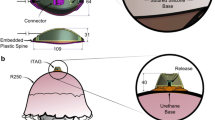Abstract
This paper reviews results of some experiments conducted in French Polynesia on tuna behaviour. A method based on the simultaneous use of two techniques, acoustic tracking and acoustic surveys, was used. Experiments were conducted within the framework of the ECOTAP program, a joint program between two national research institutes (IFREMER and ORSTOM), and a territorial institute (EVAAM).
Acoustic tags equipped with pressure sensors were used in order to record horizontal and vertical movements of one yellowfin tuna (Thunnus albacares) and two bigeye tuna (T. obesus). Trackings lasted between 13 to 24 h. In the same time, echogram data were recorded between the surface and a depth of 500 m on board the tracking vessel. As the maximum range of the acoustic tags is small (a few hundred meters), vessel and tagged fish horizontal movements are therefore treated as equivalent. Echogram data from the sounder and data on the swimming depth of the fish given by the acoustic tag are then considered as having been obtained at the same time at the same place.
Comparison between the swimming depth of the tagged fish and the echogram data from the sounder clearly shows the important role of scattering layers, assimilated as food, on vertical and horizontal tuna movements, during daytime as well as during night-time.
The method used during these experiments allows to observe a new explanatory factor of tuna behaviour: the biotic environment. At small temporal and spatial scales, structure of the biotic environment and its dynamic appear to be a key factor to understanding the vertical and horizontal tuna movements. The simultaneous technique presented here must now be improved by using behavioural activities sensors. By this way, it would be possible to elucidate different tuna foraging phases in relationship with the dynamic of scattering layers.
Similar content being viewed by others
References
Brill, R. W., 1994. A review of temperature and oxygen tolerance studies of tunas pertinent to fisheries oceanography, movements models and stock assessments. Fish. Oceanogr. 3: 204–216.
Carey, F. G., 1990. Further acoustic telemetry observations of swordfish. In Stroud, R. H. (ed), Planning the future of billfishes – Research and management in the 90s and beyond, Proceedings of the Second International Billfish Symposium, KailuaKona, Hawaii, August 1–5, 1988. Mar. Recreat. Fish. 13: 103–122.
Cayré, P., 1991. Behaviour of yellowfin tuna (Thunnus albacares) and skipjack tuna (Katsuwonus pelamis) around fish aggregating devices (FADs) in the Comoros Islands as determinated by ultrasonic tagging. Aquat. Living Resour. 4: 1–12.
Cayré, P. & J. Chabanne, 1986. Marquage acoustique et comportement de thons tropicaux (albacore: Thunnus albacares et listao: Katsuwonus pelamis) au voisinage d'un dispositif concentrateur de poissons. Océanogr. trop. 21: 167–183.
Cayré, P. & F. Marsac, 1993. Modelling the yellowfin tuna (Thunnus albacares) vertical distribution using sonic tagging results and local environmental parameters. Aquat. Living Resour. 6: 1–14.
Holland, K. N., R. W. Brill & R. K. C. Chang, 1990. Horizontal and vertical movements of yellowfin and bigeye tuna associated with Fish Aggregating Devices. Fish. Bull. 88: 493–507.
Holland, K. N., R. W. Brill, R. K. C. Chang, J. R. Sibert & D. A. Fournier, 1992. Physiological and behavioral thermoregulation in bigeye tuna (Thunnus obesus). Nature 358: 410–412.
Laurs, R. M., H. S. H. Yuen & J. H. Johnson, 1977. Small-scale movements of albacore, Thunnus alalunga, in relation to ocean features as indicated by ultrasonic tracking and oceanographic sampling. Fish. Bull. 75: 347–355.
Malinin, L. K., V. I., Kijasko & P. L. Vaaranen, 1992. Behavior and distribution of bream (Abramis brama) in oxygen deficit regions. In Priede, I. G. & S. M. S. Swift (eds), Wildlife telemetry: Remote Monitoring and Tracking of Animals. Ellis Horwood. Chichester: 297–306.
Marsac, F., P. Cayré & F. Conand, 1996. Analysis of small scale movements of yellowfin tuna around Fish Aggregating Devices (FADs) using sonic tagging. In Anganuzzi, A. A., K. A. Stobberup & N. J. Webbs (eds), Proceedings of the Expert Consultation on Indian Ocean Tunas, 6th session, Colombo Sri Lanka, 25–29 Sept. 1995. IPTP Coll. 9: 151–159.
Moarii, G. & F. Leproux, 1996. The drop-stone technique used by artisanal fishermen in French Polynesia. South Pacific Commission Fish Aggregating Device Bull. 1: 16–18.
Sund, P. N., M. Blackburn & F. Williams, 1981. Tunas and their environment in the Pacific Ocean: a review. Oceanogr. Mar. Biol. 19: 443–512.
Yuen, H. S. H., 1970. Behavior of skipjack tuna, Katsuwonus pelamis, determined by tracking with ultrasonic devices. J. Fish. Res. Bd Can. 27: 2071–2079.
Rights and permissions
About this article
Cite this article
Josse, E., Bach, P. & Dagorn, L. Simultaneous observations of tuna movements and their prey by sonic tracking and acoustic surveys. Hydrobiologia 371, 61–69 (1998). https://doi.org/10.1023/A:1017065709190
Issue Date:
DOI: https://doi.org/10.1023/A:1017065709190




